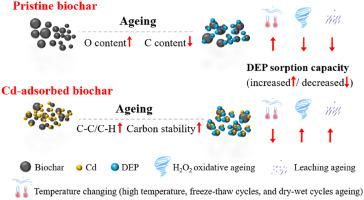Environmental Pollution ( IF 7.6 ) Pub Date : 2021-09-27 , DOI: 10.1016/j.envpol.2021.118243 Fanqi Jing 1 , Yuyan Liu 1 , Jiawei Chen 1

|
The conversion of agricultural biomass wastes into biochar has enormous potential to improve soil quality. Particularly, biochar particles introduced into the natural environment readily bind environmental pollutants. The interaction of biochar and adsorbed pollutants will, however, be impacted by long term ageing. The mechanism of biochar adsorption performance that could be affected by such early-adsorbed pollutant is not understood. Herein, we study the effects of different ageing processes on Cd-adsorbed biochar stability by K2CrO7–H2SO4 oxidation method for carbon loss evaluation, and sorption capacity towards diethyl phthalate (DEP). We adopted artificially accelerated ageing methods to simulate various processes: HNO3/H2SO4, H2O2 oxidative, leaching, high temperature, freeze-thaw cycles, and dry-wet cycles. The results showed that all the Cd-adsorbed aged biochars had more C–C/C–H functional groups and exhibited higher carbon stability than pristine aged biochars. Specially, the carbon loss (20.2–25.2%) of Cd-adsorbed biochar showed almost two times lower than pristine biochar (34.5–35.4%) after high temperature and leaching ageing due to enhancing Cd-π bonding, which could resist strong K2Cr2O7/H2SO4 oxidation. Such interaction synergistically promoted the sequestration of adsorbed Cd on biochars. The subsequent sorption performance for DEP on Cd-adsorbed biochars was slightly higher than pristine biochar after H2O2 oxidative and leaching ageing. Whereas, the dominate mechanism of DEP removal on Cd-adsorbed biochars changed to hydrophobic partitioning after high temperature, freeze-thaw cycles and dry-wet cycles ageing, leading to a decreased DEP sorption capacity. Hence, the biochar application must be comprehensively considered the susceptibilities due to reciprocal effects of early adsorbed pollutant and natural ageing environment, which helps us both assess and take measures to minimize potential risks in the environment. The present study suggests the continuous irrigation and tropical or temperature climate regions would be suitable for long-term biochar application in soil remediation and carbon sequestration.
中文翻译:

深入了解老化过程对 Cd 吸附生物炭稳定性和后续吸附性能的影响
将农业生物质废物转化为生物炭具有改善土壤质量的巨大潜力。特别是,引入自然环境中的生物炭颗粒很容易与环境污染物结合。然而,生物炭和吸附污染物的相互作用会受到长期老化的影响。这种早期吸附的污染物可能影响生物炭吸附性能的机制尚不清楚。在此,我们通过 K 2 CrO 7 –H 2 SO 4氧化法研究了不同老化过程对 Cd 吸附生物炭稳定性的影响,用于评估碳损失,以及对邻苯二甲酸二乙酯 (DEP) 的吸附能力。我们采用人工加速老化方法来模拟各种过程:HNO3 /H 2 SO 4、H 2 O 2氧化、浸出、高温、冻融循环和干湿循环。结果表明,所有吸附 Cd 的老化生物炭都具有更多的 C-C/C-H 官能团,并且表现出比原始老化生物炭更高的碳稳定性。特别是在高温和浸出老化后,Cd 吸附生物炭的碳损失(20.2-25.2%)几乎比原始生物炭(34.5-35.4%)低两倍,这是由于增强了 Cd-π 键,可以抵抗强 K 2 Cr 2 O 7 /H 2 SO 4氧化。这种相互作用协同促进了吸附在生物炭上的 Cd 的螯合。在 H 2 O 2后,DEP 对 Cd 吸附生物炭的后续吸附性能略高于原始生物炭氧化和浸出老化。然而,在高温、冻融循环和干湿循环老化后,吸附 Cd 的生物炭去除 DEP 的主要机制转变为疏水分配,导致 DEP 吸附能力下降。因此,生物炭应用必须综合考虑早期吸附污染物和自然老化环境相互影响的敏感性,这有助于我们评估并采取措施将环境中的潜在风险降至最低。目前的研究表明,连续灌溉和热带或温度气候地区将适合在土壤修复和固碳中长期应用生物炭。









































 京公网安备 11010802027423号
京公网安备 11010802027423号